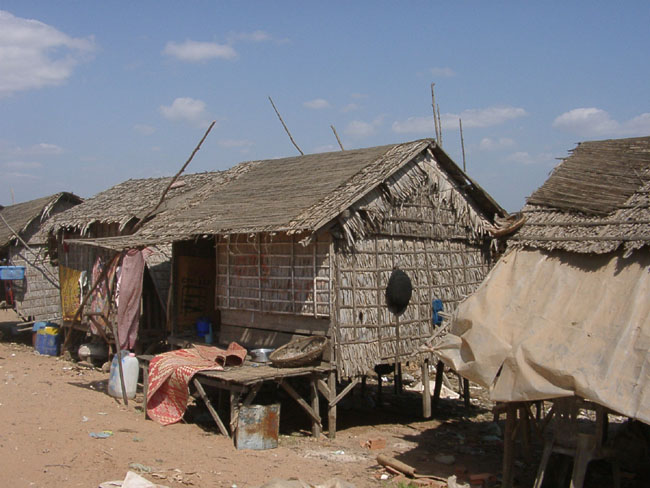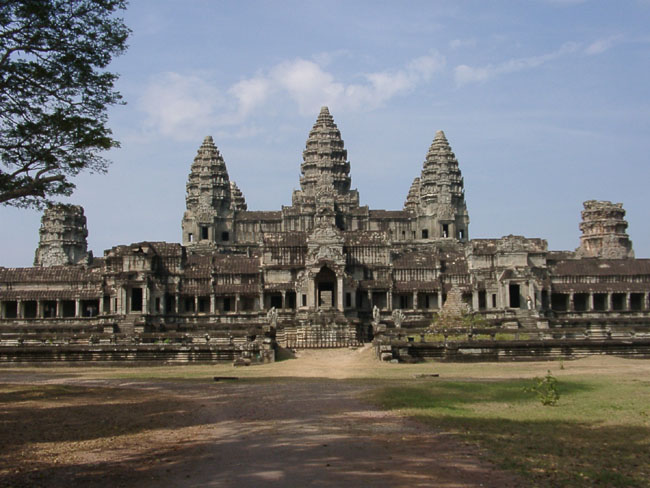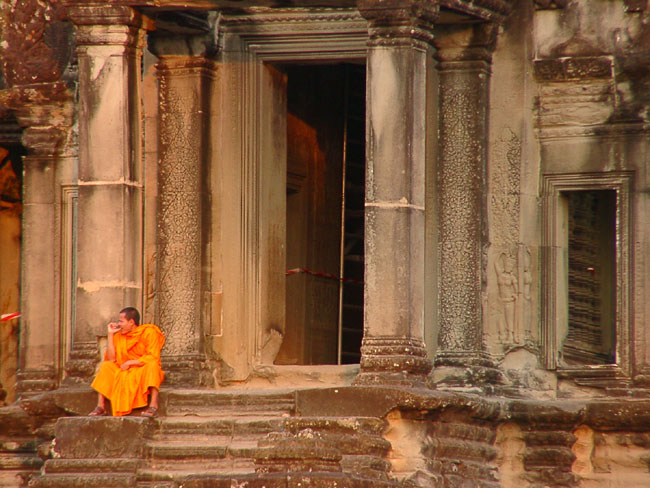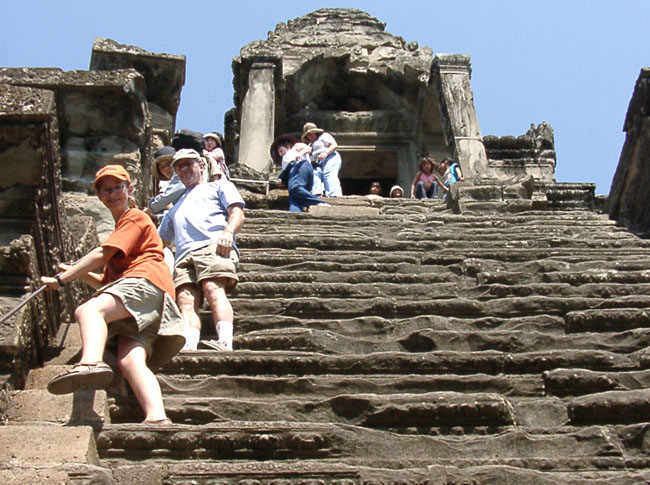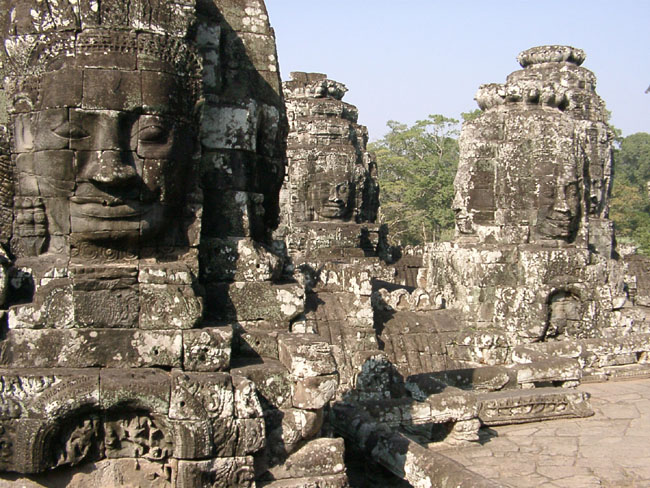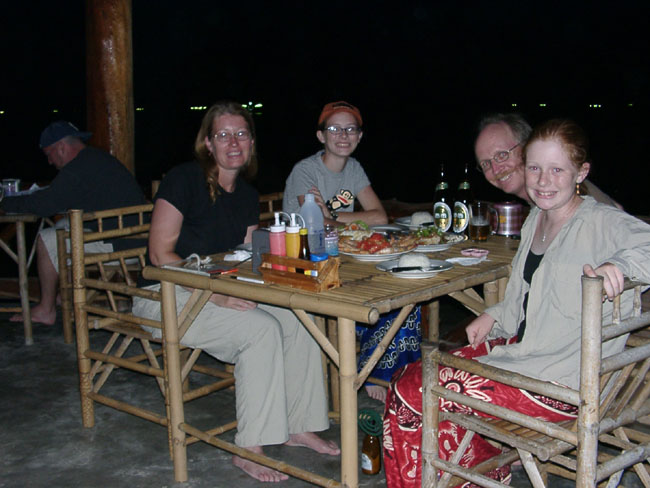| «Back to Previous Post |
Date: Friday, 23 January 2004 03:06 PST
Subject: Greetings from Southern Thailand
Captions for photos:
1. Poor village leaving Phnom Krom on road to Siem Reap
2. View from east gate of Angkor Wat
3. Buddhist monk at Angkor Wat
4. Steep stairs at Angkor Wat
5. The Banyon Temple at Angkor Thom
6. The beach at Ko Pha-Ngan
7. Squid drying at the fishing village on Ko Pha-Ngan
8. Dinner at Ocean View at Ko Pha-Ngan
22 January 2004 – Day #124
We are currently flying from Ko Sumui to Bangkok. We will spend the night at the Comfort Suites near the airport in anticipation of our next flight to Paris on Friday night. In Paris, we will meet up with Sandy’s folks, spending four nights there before traveling to our final destination – London.
The Ko Sumui archipelago is located in Southern Thailand. It is made up of three major islands: Ko Sumui, Ko Pha-Ngan and Ko Tao. We spent three days on the second island in the chain mostly eating, sleeping, swimming and reflecting on our trip. We stayed at the Ocean View — one of many resorts on the island.
The Ocean View is a small resort with just 10 bungalows and a restaurant. It sits on a white, sandy beach within a small bay, surrounded by coconut trees on the north side of the island. This bay is well protected by a coral reef. This reef is only visible at low tide. At high tide, the reef gives the water a beautiful light-blue color. The Ocean View is accessible by either a water taxi from the fishing village located at the next bay to the west or by dirt road. The condition of the road is poor, requiring the use of a four-wheel drive vehicle.
While our flight back to Bangkok is fairly painless, it took almost 24 hours to get to Ko Pha-Ngan. It involved an all-night train from Bangkok, a one-hour bus ride to the coast, a five-hour ferry ride to Ko Pha-Ngan and a 45-minute drive to the resort. We intended to stay at another nearby resort, but the taxi they promised failed to pick us up. After waiting a hour, we gave up and called our second choice.
Our bungalow was between 15 and 25 feet from the water, depending on the tide. It contained two rooms and a bath. We had electricity from 6pm until midnight. In the morning, we awoke to the sound of either the waves lapping the beach or a water taxi ferrying passengers from the fishing village to the next bay over from ours. At night, we could see the lights of fishing boats. Evidently, the boats use the lights to attract squid, which they catch in large numbers. We saw the squid drying in the sun in the fishing village during our visit.
The cost of our room was one of the cheapest on our trip – about $15 per night. The restaurant was equally inexpensive and delicious. On our last night, we had fresh prawns, squid and white snapper. All three dishes were made Thai style – spicy! The only real downside to our resort was the bugs – the mosquitoes at dusk were ravenous. We were forced to cover up at about 4pm and put on repellent for good measure. When we went to dinner, the waiter lit a mosquito coil and placed it under our table.
When we last wrote, we were traveling up the Tonle Sap River to Siem Reap — the town closest to the temples of Angkor. After about five-and-half hours, we arrived at the port of Phnom Krom, 11km from Siem Reap. The situation as we docked was complete bedlam. As we mentioned in our previous email, our boat carried about 90 passengers who were now either getting off the boat or walking to the back to get their bags from the cargo hold. On the dock, there were easily twenty to thirty touts all jostling for position. As the first passengers got off, they were literally bombarded with offers of luxury accommodation at budget prices. Fortunately, we had booked a room before we arrived, arranging for transportation at the same time.
Since we were one of the first to get on the boat in Phnom Penh, our bags were the last to be unloaded. We instructed the kids to get off the boat and wait there as we collected our luggage. Because the deck was full of crew members and other travelers, we took turns ferrying the bags over the length of the boat to the dock. By this time, Kristen had caught the eye of our taxi driver, who was holding a sign with our surname and the name of our hotel.
It was 1pm and easily 90 degrees and 80 percent humidity outside. The driver’s taxi was about 300 feet away from the dock. We loaded the gear and got into the Toyota van. As we closed the door, a naked three-year-old boy appeared with hands outstretched in hopes of a contribution.
The first part of our ride to Siem Reap was on a dirt road. (Even in Phnom Penh, many of the roads are unpaved — even ones that intersect the main roads in the city center. Many of these roads have deep ruts that are impassible during the wet season.) Along the way, we saw a long row of approximately six-by-nine foot stilted bamboo huts built on the uneven embankment between the road and the rice fields below. They were surrounded by trash. It was obvious by their potbellies that the children were severely malnourished. The living conditions here were perhaps the worst we had seen on the entire trip. This was the poorest of the poor.
Once we left the dirt road, the conditions improved markedly. Before we knew it, we were driving along the Stung Siem Reap River near the town center. Our hotel, the Pavillon Indochine, was off a dirt road a few miles north of the town. Later, we met the owner of the hotel, a Frenchman named Frederic Amat. Fred is a retired journalist in his 40’s who covered Cambodia for the French newspaper – L’Independant and the Agence France Presse (AFP) from 1993 to 1998. On several occasions during our stay, Darren had the opportunity to discuss Cambodia’s history with him.
Just a few hours after we arrived, we went to the entrance of the park to purchase our tickets for Angkor. There are over 40 temple sites in the Siem Reap area, so we purchased three-day passes. From our guidebook, we learned that if we purchased our tickets after 5pm, we could use them that evening before the park closed, in addition to the three additional full days. At 4:50pm, we had our tickets and were on the park road leading to Angkor Wat, the major temple site in the area. After agreeing on a meeting point with our driver, we crossed the causeway over the moat and entered the temple complex through the west gate. Needless to say, the view of Angkor Wat at sunset met all of our expectations.
We returned to our rooms for a shower and, later, dinner in the hotel’s outdoor restaurant. As we ate, we noticed that we were sharing the restaurant with frogs (small, smooth and slimy) and toads (larger, bumpy and dry). We counted about six or seven frogs/toads, several small lizards and three cats. The electric lights flickered due to voltage fluctuations. Besides a few motorcycles, the only thing we could hear was crickets. Most of the hotel’s other guests were French. The food was excellent.
Though we promised ourselves we wouldn’t ride on the back of the taxi motorcycles in Phnom Penh, this was really the only way to get around the Angkor area without hiring a car (US$25) for the entire day. The next day, we hired two ‘motos’ for US$4 to bring us back to the temples. (Even though the official currency is the Riel, we paid for everything during our visit in Cambodia in US Dollars. Dollars have been used since 1979 in an attempt to improve stability after the post-war period.) Darren and Kristen rode on one moto with Sandy and Lauren on the other.
We spent the morning back at Angkor Wat climbing up and down the near-vertical stairs and exploring the rich bas-relief carvings covering the huge three-story structure. In the afternoon, we took a remorque-moto (a hooded carriage towed behind a motorcycle) a mile north to the ancient city of Angkor Thom.
In the center of Angkor Thom, we visited a temple surrounded by the jungle called the Banyon. This unique temple features 54 Gothic towers decorated with 216 nearly-identical stone faces. We spent nearly two hours here climbing up and down the steep stairs, through the tunnels and many rooms. Many of these rooms contained lifeless Buddha idols draped with a gold-orange sash. Invariably, as we approached one of these rooms, a monk appeared offering a lit stick of incense in return for a small donation. In addition to the smell of incense, many of the rooms also had another smell – bat urine! The Banyon was infested with these critters. You would hear them squeak as you approached some of the conical towers.
The next day, we hired a car for the entire day in order to explore other temples in the surrounding countryside. Some had beautiful carvings, while others had been totally left to the jungle and were in ruins. On the way, we got a glimpse of rural life in average Cambodian villages. While some of the homes were made of bamboo, most were elevated homes made of wood for the walls and tin for the roof.
Our last day at Angkor was spent revisiting some of the earlier sites. Overall, we felt it was a very special place. The Cambodian people were friendly, honest and hospitable.
God’s Blessings,
Darren and Sandy
| «Back to Previous Post |

